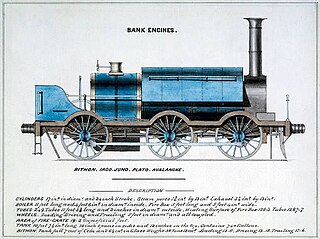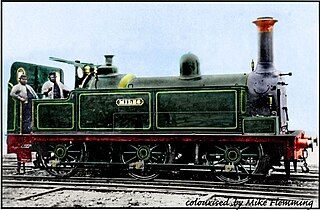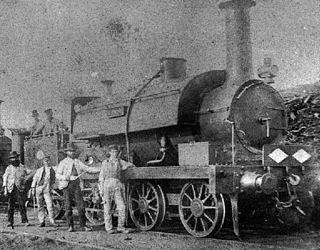
The Great Western Railway (GWR) was a British railway company that linked London with the southwest, west and West Midlands of England and most of Wales. It was founded in 1833, received its enabling Act of Parliament on 31 August 1835 and ran its first trains in 1838 with the initial route completed between London and Bristol in 1841. It was engineered by Isambard Kingdom Brunel, who chose a broad gauge of 7 ft —later slightly widened to 7 ft 1⁄4 in —but, from 1854, a series of amalgamations saw it also operate 4 ft 8+1⁄2 in standard-gauge trains; the last broad-gauge services were operated in 1892.

4-4-0 is a locomotive type with a classification that uses the Whyte notation for the classification of steam locomotives by wheel arrangement and represents the arrangement: four leading wheels on two axles, four powered and coupled driving wheels on two axles, and a lack of trailing wheels. Due to the large number of the type that were produced and used in the United States, the 4-4-0 is most commonly known as the American type, but the type subsequently also became popular in the United Kingdom, where large numbers were produced.

The first Locomotives of the Great Western Railway (GWR) were specified by Isambard Kingdom Brunel but Daniel Gooch was soon appointed as the railway's Locomotive Superintendent. He designed several different 7 ft 1⁄4 in broad gauge types for the growing railway, such as the Firefly and later Iron Duke Class 2-2-2s. In 1864 Gooch was succeeded by Joseph Armstrong who brought his standard gauge experience to the workshops at Swindon. To replace some of the earlier locomotives, he put broad gauge wheels on his standard gauge locomotives and from this time on all locomotives were given numbers, including the broad gauge ones that had previously carried just names.

The Banking Class were five 0-6-0ST Brunel gauge steam locomotives for assisting ("banking") trains up inclines on the Great Western Railway. Designed by Daniel Gooch, they were tank engine versions of his Standard Goods class, and mainly built at Swindon Works.

The Great Western Railway Premier Class 0-6-0 broad gauge steam locomotives for goods train work. This class was introduced into service between February 1846 and May 1847, and withdrawn between March 1866 and June 1872.

The Great Western Railway Metropolitan Class2-4-0T broad gauge steam locomotives with condensing apparatus were used for working trains on the Metropolitan Railway. The equipment was later removed, though the class continued to work suburban trains on GWR lines in London. The class was introduced into service between June 1862 and October 1864, and withdrawn between June 1871 and December 1877.
The Great Western Railway (GWR) Bogie Class4-4-0ST were broad gauge steam locomotives for passenger train work. The first two locomotives of this class were introduced into service in August/September 1849, with the remainder following between June 1854 and March 1855. All but one were withdrawn between October 1871 and 1873, with the final locomotive being withdrawn in December 1880.

The Great Western Railway Sir Watkin Class were 0-6-0T broad gauge steam locomotives. They were designed for working goods trains through to the underground Metropolitan Railway in London. This class was introduced into service between December 1865 and the last was withdrawn at the end of the GWR broad gauge in May 1892. They were all named after directors and senior officers of the railway.
The Great Western Railway Swindon Class 0-6-0 broad gauge steam locomotives for goods train work. This class was introduced into service between November 1865 and March 1866, and withdrawn between June 1887 and the end of the GWR broad gauge in May 1892. The entire class was sold to the Bristol and Exeter Railway between July 1872 and September 1874, where they were numbered 96-109, but returned to the GWR when that railway was absorbed. The locomotives were then renumbered 2077-2090; their names were not restored.

Newton Abbot railway station serves the town of Newton Abbot in Devon, England. It is 214 miles 5 chains (345 km) from London Paddington. The station today is managed by Great Western Railway, who provide train services along with CrossCountry.
Coeur de Lion is a title used to describe several medieval monarchs:

The Waverley Novels are a long series of novels by Sir Walter Scott (1771–1832). For nearly a century, they were among the most popular and widely read novels in Europe.

South Devon Railway locomotives were broad gauge locomotives that operated over the South Devon Railway, Cornwall Railway, and West Cornwall Railway in England. They were, at times, operated by contractors on behalf of the railways.
The four Tornado class locomotives were 0-6-0ST broad gauge locomotives operated on the South Devon Railway and associated railways. They were designed for goods trains but were also used on passenger trains when required.

The Bristol and Exeter Railway locomotives worked trains on the Bristol and Exeter Railway from 1 May 1849 until the railway was amalgamated with the Great Western Railway on 1 January 1876.
The 26 Bristol and Exeter Railway 4-4-0ST locomotives were broad gauge 4-4-0ST steam locomotives. They first entered service in 1855 and the last was withdrawn in 1892. The Bristol and Exeter Railway was amalgamated into the Great Western Railway on 1 January 1876.
The Bristol and Exeter Railway 0-6-0 locomotives include three different types of broad gauge and standard gauge 0-6-0 steam locomotives designed for working freight trains. On 1 January 1876 the Bristol and Exeter Railway was amalgamated with the Great Western Railway, after which the locomotives were given new numbers.

The Hercules Class were four broad gauge steam locomotives for the Great Western Railway. They were the first 0-6-0 locomotives, being built in 1842 by Nasmyth, Gaskell and Company.
Lalla Rookh is a poem written in 1817 by Irish poet Thomas Moore.











